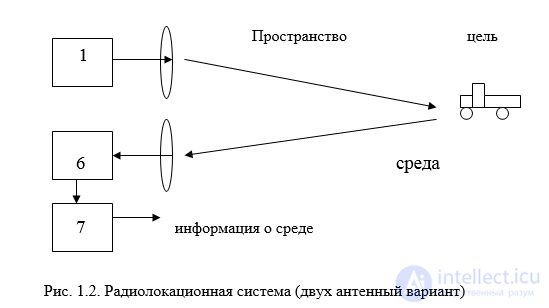Any radio system transmits information through a radio channel. In fig. 1.1. given the generalized composition of the channel. Carrier frequency generator 1 generates electrical high frequency (HF) colo *** s. Information from source 2 is superimposed on them, or else modulation takes place in element 3. The carrier, which contains information in its structure, is converted into electromagnetic waves in antenna 4 and propagated in space. A part of them gets into the receiving antenna 5 and is converted into electric columns ***, then amplified in the receiver 6. The detector 7 extracts information and transmits it to the consumer - the information receiver 8. In addition to the information transmitted from source 2, as the space passes, the radio wave acquires also the properties of space. They can be both useful and harmful in solving the main problem.
From here it is possible to note two types of radio engineering systems: systems for transmitting and receiving information and systems in which information is extracted from a carrier that has passed through a medium.

Fig. 1.1. The general structure of the radio channel: 1 - carrier generator; 2 - source of information; 3 - device overlay information on the carrier ; 4,5 - transmitting and receiving antennas; 6 - carrier receiver; 7 - information detector; 8 - receiver information.
The first type includes radio communication systems, radio and television broadcasting and others. To the second type - radar systems and radio navigation. For example, The radar station extracts information from a space whose element is the object being located — the target.

Fig. 1.2. Radar system (two antenna version)
The main indicators of the radio system
The main indicators of the radio system include:
- range of action;
- accuracy of information transfer or errors occurring during transmission and reception;
- the probability of detecting a received signal and a false alarm;
- energy costs for the organization of the radio channel;
- weight and size characteristics;
- cost.


Comments
To leave a comment
Radio Engineering Systems
Terms: Radio Engineering Systems